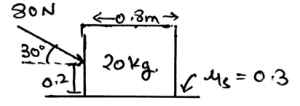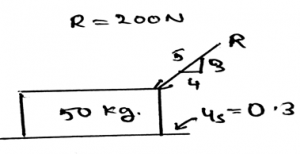This set of Engineering Mechanics Question Bank focuses on “Characteristics of Dry Friction – 3”.
1. The maximum value of the frictional force is called _________
a) Limiting Friction
b) Non-Limiting Friction
c) Limiting Action Friction
d) Non-Limiting Action Friction
View Answer
Explanation: The friction is the phenomena that define that there is a resistance which is present there between the two surfaces. The two surfaces are in contact and the friction applies at that surface only, resisting the motion of the surface. Thus the maximum values are called as limiting friction.
2. When the body which is applied forces come in the stage of the limiting friction then the body is termed as to come in ___________ equilibrium.
a) Unstable
b) Stable
c) Non-stable
d) Improper Stable
View Answer
Explanation: As the limiting friction is the maximum value of the frictional forces. Thus if more force is applied to the body then the body is going to move forward. Because the two surfaces are in contact and the friction applies at that surface only, resisting the motion of the surface. Thus the name unstable equilibrium.
3. The frictional force is directly proportional to the ____________
a) Applied load
b) Type of surface used
c) The normal force
d) The horizontal load
View Answer
Explanation: The frictional force is directly proportional to the vertical force that is being applied normal to the surface of the body. The force of friction is not dependent on the type of the surface. Thus the only thing the frictional force does depend is the normal force.
4. The constant in the equation F = µN is called?
a) Knew
b) Proprietary Constant
c) Coefficient of dry friction
d) Coefficient of static friction
View Answer
Explanation: The constant in the equation F = µN is known as the coefficient of static friction. This is the proportionality constant and is generally used to express the equation of the frictional force. The value of this constant is generally from 0 to infinite, depending on the surface.
5. The coefficient of static friction does depend upon the surface on which the body is being slide.
a) True
b) False
View Answer
Explanation: The constant in the equation F = µN is known as the coefficient of static friction. This is the proportionality constant and is generally used to express the equation of the frictional force. The value of this constant is generally from 0 to infinite, depending on the surface.
6. The coefficient of friction is generally determined by ____________
a) Written over the Body
b) Experiments
c) Weighing the body
d) Measuring length of the body
View Answer
Explanation: The coefficient of friction is generally determined by the help of experiments. Many experiments are done on the body. Try and error methods are involved. And the final observations are being taken out. Then the average of all the final answers resulted in the experiments is done.
7. We have two types of a coefficient of friction, one is coefficient of static friction and the other one is the coefficient of the kinetic friction.
a) True
b) False
View Answer
Explanation: The constant in the equation F = µN is known as the coefficient of static friction. This is the proportionality constant and is generally used to express the equation of the frictional force. And in the same equation the constant is sometimes called a coefficient of kinetic friction, when the limiting value of static friction is passed over.
8. The angle of the inclination of wedge over which the block is sliding is determined by which of the following trigonometric function?
a) Tangent Inverse
b) Cosine
c) Sine
d) Secant
View Answer
Explanation: The angle of the wedge over which the block is being slided is generally taken out by the help of the tangent inverse trigonometric function. It is the ratio of the frictional force to the normal force. This ratio is kept inside the inverse function.
9. The coefficient of kinetic friction is ____________ than coefficient of static friction.
a) Smaller
b) Larger
c) Significantly larger
d) Highly larger
View Answer
Explanation: The coefficient of kinetic friction is smaller than the coefficient of static friction. The main thing about the kinetic one is that it is applied by the surface when the body is in motion. The static one is applied to the body when the body is static and is about to move.
10. The kinetic friction is applied when the body is __________
a) Moving
b) Stopped
c) Just stopped
d) Just started to move
View Answer
Explanation: The kinetic friction is applied to the body by the surface when the body is moving. This means there is friction present and the coefficient of that friction is smaller than the static one. The main observation is that this is applied when the static friction attends its maximum value.
11. The angle of the inclination of wedge over which the block is sliding and is experiencing the kinetic friction is determined by which of the following trigonometric function?
a) Tangent Inverse
b) Cosine
c) Sine
d) Secant
View Answer
Explanation: The angle of the wedge over which the block is being slided is generally taken out by the help of the tangent inverse trigonometric function. Whether it may be the static or the kinetic friction, the ratio is the frictional force to the normal force. And this ratio is kept inside the inverse function.
12. The value of a coefficient of friction is taken at that moment when the block is at the verge of moving.
a) True
b) False
View Answer
Explanation: The constant in the equation F = µN is known as the coefficient of static friction. This is the proportionality constant and is generally used to express the equation of the frictional force. And this coefficient is calculated by the help of experiments and is generally observed when the block is at the verge of moving.
13. For determination of the equilibrium state in the free body diagram the basic way of getting the direction of the moment caused by the force is:
a) The use of left hand rule with thumb giving the direction of the moment
b) The use of right hand rule with thumb giving the direction of the moment
c) The use of right hand rule with forefinger giving the direction of the moment
d) The use of left hand rule with forefinger giving the direction of the moment
View Answer
Explanation: The basic way of doing so is to use right hand rule and not the left hand rule. The direction of the moment axis is given by the thumb. The direction of the force is given by the fingers. As we place the fingers on the force and curl towards the rotational direction of the body about the axis.
14. Determine the frictional force acting in the given figure.

a) 63.9N
b) 60N
c) 43N
d) 83N
View Answer
Explanation: None.
15. Which of the following is the force developed between the body and the surface.
a) 160N
b) 16N
c) 10N
d) 180N
View Answer
Explanation: The net forces acting on the body is shown with the help of the resultant forces. There are two types, first the frictional and the second is normal. This is because the resultant forces have the sum of all the forces which are acting in the direction which is same.
Sanfoundry Global Education & Learning Series – Engineering Mechanics.
To practice Engineering Mechanics Question Bank, here is complete set of 1000+ Multiple Choice Questions and Answers.
If you find a mistake in question / option / answer, kindly take a screenshot and email to [email protected]

